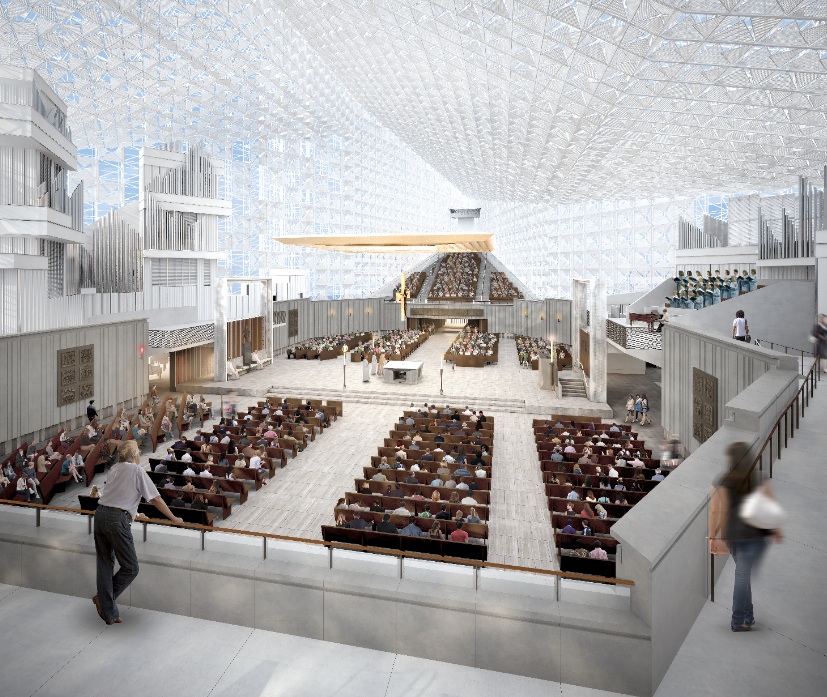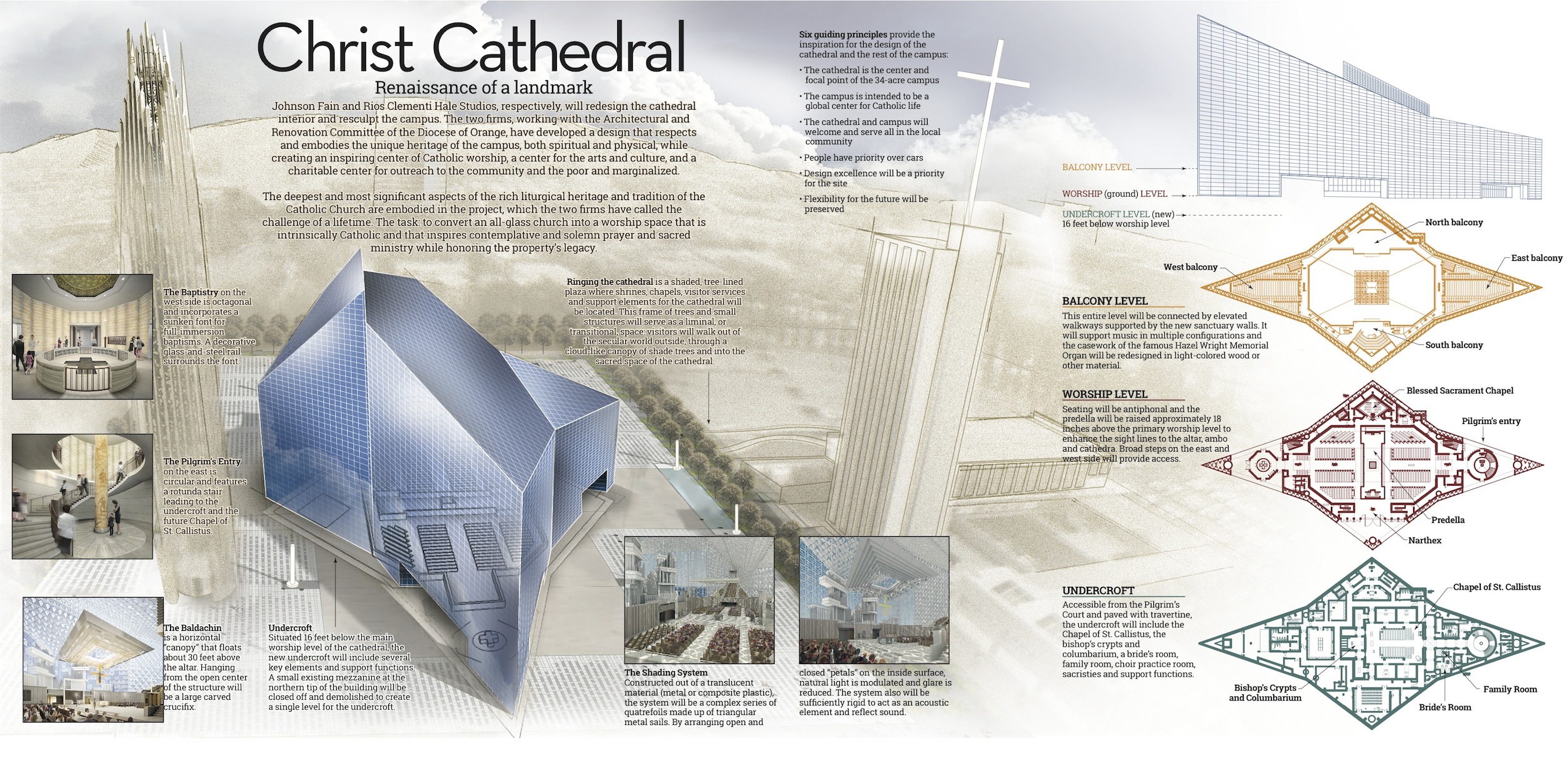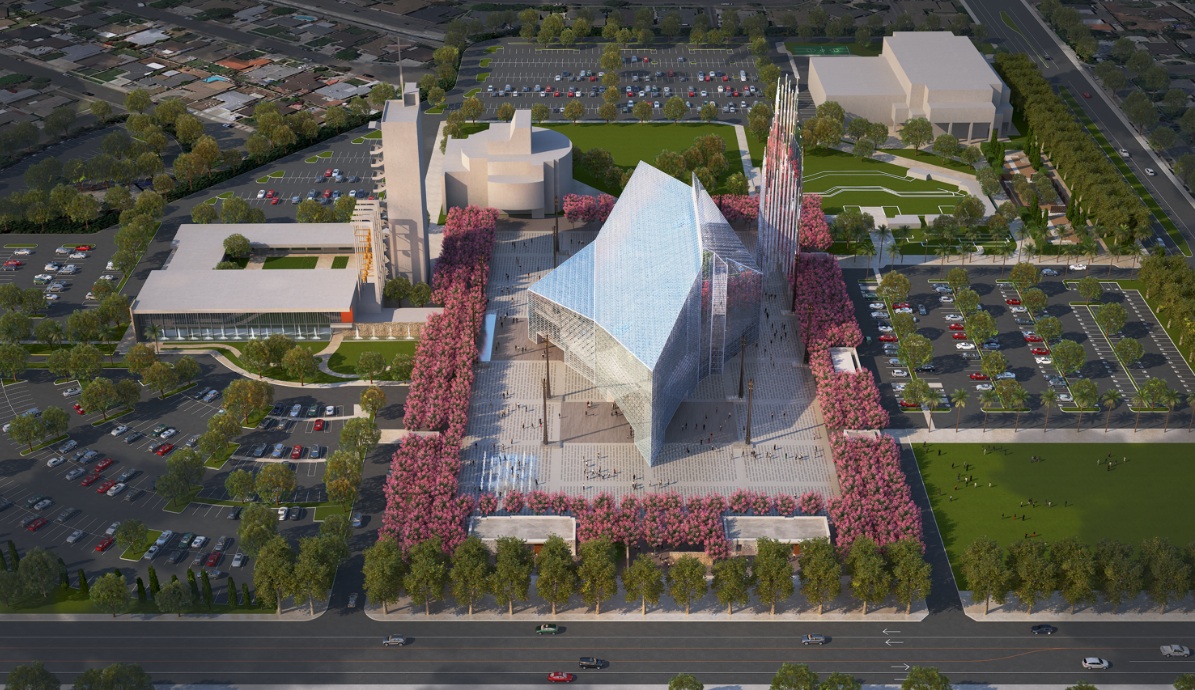The Roman Catholic Diocese of Orange has two retained architectural firms, Johnson Fain (with a focus on the Cathedral building itself) and Rios Clementi Hale Studios (with a focus on the exterior spaces), to create a design plan that addresses the complex needs of the 1.3-million-member diocese and the day-to-day needs of a more than 10,000-member Cathedral parish.
In addition to addressing these pressing needs, the design committee was tasked to develop a multifaceted plan that not only addressed the complex design requirements of transforming the Christ Cathedral into a space that is both liturgically and intrinsically Catholic, but also addresses a variety of intricate engineering challenges to bring the building and its grounds to the cutting-edge with regard to technology and site usability.
Within the interior of the cathedral the design ethic conserves and revitalizes the excellent and inspirational architecture that exists while transforming the space into one that supports the liturgical aspects of the Catholic faith and the centrality of the Eucharist.
The exterior design of the site works to create a structure and theme commensurate with the dynamism and beauty of the existing structures. This new landscape and the new spaces that will be created honor the history of the site, its architecture, and its worshippers while also enabling its renewed life as a Roman Catholic cathedral.
The design reinforces the liturgical importance of the cathedral building in relation to the adjacent buildings and welcomes pilgrims into an experience of faith as they enter the campus and cathedral.
PEDALS OF LIGHT
The design team confronted several dynamic challenges throughout this process unique to creating a Catholic cathedral that supports a solemn and prayerful experience from an existing structure. Given the glass façade of the cathedral, heat transfer, excess light, and acoustics presented a significant challenge. To address this, the design team developed an innovative treatment to be installed on the ceiling of the cathedral. The proposed treatment will be composed of a series of four rigid "petals" that cover each of the more than 10,000 panes of glass, opening between 15 and 45 degrees.
These petals will not only control light and heat transfer, but will assist with the acoustic properties of the space. The placement and aperture of the petals was a result of analyzing the sun's path of travel across the building's façade, an analysis of existing acoustic reverberation times and a careful study of how new lighting can be coordinated to cover the large and tall volume.
Additionally, the placement of the altar, the center point of the Catholic Mass, presented a challenge given the nearly one million cubic feet of space and the visually arresting Hazel Wright Organ, the fourth largest within a Church in the world. The liturgical experts and design team addressed this issue by drawing inspiration from the historical tradition of the Church. One of the oldest forms of a Catholic Church is an antiphonal layout, with the altar at the center of the space, with congregants on either side. This layout and altar placement allows for the maximum use of the space while ensuring the altar is truly the center point of focus within the cathedral.
This ambitious project has been divided into two phases of work: phase one will address itself to the worship level of the cathedral, major infrastructure elements, the cathedral courtyard and a reflection garden that will house the existing campus statuary and beautiful replicas of the more than 1800 "Walk of Faith" stones currently throughout the campus. Phase two will include an expansion of the Cathedral Memorial Gardens Cemetery, the undercroft, or lower level of the cathedral, and the remainder of the Master Plan for the campus grounds.
There is a $29 million allocation from the $100 million For Christ Forever capital campaign to support phase one of this project. Additional funding is being raised for this development plan through a long-planned "leadership gift" phase of the capital campaign.
HISTORY OF CHRIST CATHEDRAL
In the late 1970s, legendary American architect Philip Johnson and his partner John Burgee presented their designs for an "all-glass church" to Reverend Robert Schuller. Upon seeing the plans, Reverend Schuller exclaimed, "Wow, it looks like a crystal cathedral!" The building was a massive undertaking, taking over two years to complete. Standing 120 feet tall (12 stories), 141 feet long and 207 feet wide, this 78,397-square-foot edifice is constructed entirely of glass and steel.
With more than 10,000 panes of mirrored glass, the cathedral structure is known the world over for its inspiring beauty and breathtaking scale. The main sanctuary seats more than 2,000 people and will become a spiritual home to Orange County's more than 1.3 million Catholics. The cathedral has closed for an extensive renovation to remake the space as a place of Catholic worship and will reopen after its formal dedication in 2017.
Related Stories
Mass Timber | Jun 10, 2024
5 hidden benefits of mass timber design
Mass timber is a materials and design approach that holds immense potential to transform the future of the commercial building industry, as well as our environment.
Lighting | Jun 10, 2024
LEDs were nearly half of the installed base of lighting products in the U.S. in 2020
Federal government research shows a huge leap in the penetration of LEDs in the lighting market from 2010 to 2020. In 2010 and 2015, LED installations represented 1% and 8% of overall lighting inventory, respectively.
Libraries | Jun 7, 2024
7 ways to change 'business as usual': The Theodore Roosevelt Presidential Library
One hundred forty years ago, Theodore Roosevelt had a vision that is being realized today. The Theodore Roosevelt Presidential Library is a cutting-edge example of what’s possible when all seven ambitions are pursued to the fullest from the beginning and integrated into the design at every phase and scale.
Education Facilities | Jun 6, 2024
Studio Gang designs agricultural education center for the New York City Housing Authority
Earlier this month, the City of New York broke ground on the new $18.2 million Marlboro Agricultural Education Center (MAEC) at the New York City Housing Authority’s Marlboro Houses in Brooklyn. In line with the mission of its nonprofit operator, The Campaign Against Hunger, MAEC aims to strengthen food autonomy and security in underserved neighborhoods. MAEC will provide Marlboro Houses with diverse, community-oriented programs.
Office Buildings | Jun 6, 2024
HOK presents neurodiversity research and design guidelines at SXSW 2024
Workplace experts share insights on designing inclusive spaces that cater to diverse sensory processing needs.
Architects | Jun 4, 2024
HED and Larson Incitti Architects merge, combine Denver staff
HED, a leading national architecture and engineering firm, today announced a merger with award-winning, Denver-based Larson Incitti Architects (LIA). The merger combines LIA's staff with HED's Denver office, significantly expanding the local team and leveraging community relationships to create new opportunities across multiple market sectors.
Airports | Jun 3, 2024
SOM unveils ‘branching’ structural design for new Satellite Concourse 1 at O’Hare Airport
The Chicago Department of Aviation has revealed the design for Satellite Concourse 1 at O’Hare International Airport, one of the nation’s business airports. Designed by Skidmore, Owings & Merrill (SOM), with Ross Barney Architects, Juan Gabriel Moreno Architects (JGMA), and Arup, the concourse will be the first new building in the Terminal Area Program, the largest concourse area expansion and revitalization in the airport’s almost seven-decade history.
Office Buildings | Jun 3, 2024
Insights for working well in a hybrid world
GBBN Principal and Interior Designer Beth Latto, NCIDQ, LEED AP, ID+C, WELL AP, share a few takeaways, insights, and lessons learned from a recent Post Occupancy Evaluation of the firm's Cincinnati, Ohio, office.
Multifamily Housing | Jun 3, 2024
Grassroots groups becoming a force in housing advocacy
A growing movement of grassroots organizing to support new housing construction is having an impact in city halls across the country. Fed up with high housing costs and the commonly hostile reception to new housing proposals, advocacy groups have sprung up in many communities to attend public meetings to speak in support of developments.
MFPRO+ News | Jun 3, 2024
New York’s office to residential conversion program draws interest from 64 owners
New York City’s Office Conversion Accelerator Program has been contacted by the owners of 64 commercial buildings interested in converting their properties to residential use.


























